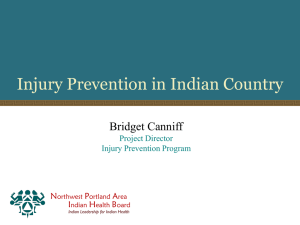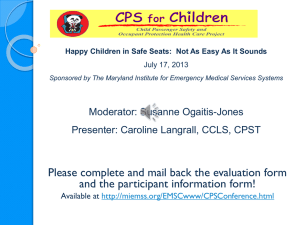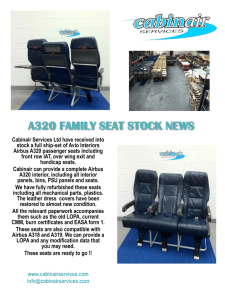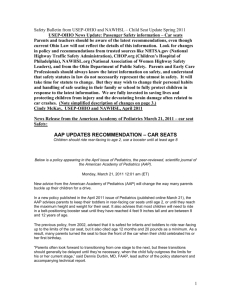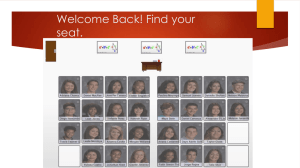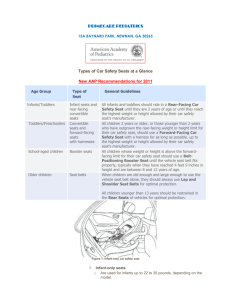National-CPS-Certification-Training-Program-curriculum
advertisement
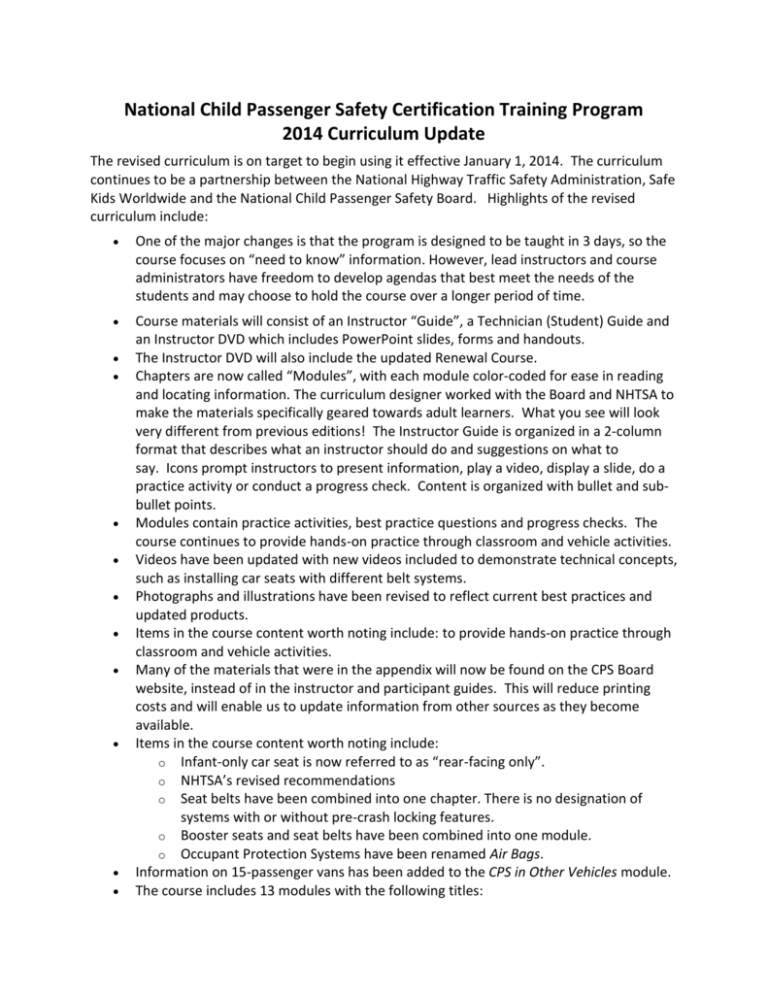
National Child Passenger Safety Certification Training Program 2014 Curriculum Update The revised curriculum is on target to begin using it effective January 1, 2014. The curriculum continues to be a partnership between the National Highway Traffic Safety Administration, Safe Kids Worldwide and the National Child Passenger Safety Board. Highlights of the revised curriculum include: One of the major changes is that the program is designed to be taught in 3 days, so the course focuses on “need to know” information. However, lead instructors and course administrators have freedom to develop agendas that best meet the needs of the students and may choose to hold the course over a longer period of time. Course materials will consist of an Instructor “Guide”, a Technician (Student) Guide and an Instructor DVD which includes PowerPoint slides, forms and handouts. The Instructor DVD will also include the updated Renewal Course. Chapters are now called “Modules”, with each module color-coded for ease in reading and locating information. The curriculum designer worked with the Board and NHTSA to make the materials specifically geared towards adult learners. What you see will look very different from previous editions! The Instructor Guide is organized in a 2-column format that describes what an instructor should do and suggestions on what to say. Icons prompt instructors to present information, play a video, display a slide, do a practice activity or conduct a progress check. Content is organized with bullet and subbullet points. Modules contain practice activities, best practice questions and progress checks. The course continues to provide hands-on practice through classroom and vehicle activities. Videos have been updated with new videos included to demonstrate technical concepts, such as installing car seats with different belt systems. Photographs and illustrations have been revised to reflect current best practices and updated products. Items in the course content worth noting include: to provide hands-on practice through classroom and vehicle activities. Many of the materials that were in the appendix will now be found on the CPS Board website, instead of in the instructor and participant guides. This will reduce printing costs and will enable us to update information from other sources as they become available. Items in the course content worth noting include: o Infant-only car seat is now referred to as “rear-facing only”. o NHTSA’s revised recommendations o Seat belts have been combined into one chapter. There is no designation of systems with or without pre-crash locking features. o Booster seats and seat belts have been combined into one module. o Occupant Protection Systems have been renamed Air Bags. Information on 15-passenger vans has been added to the CPS in Other Vehicles module. The course includes 13 modules with the following titles: Program Introduction – purpose, goals and requirements of course; costs associated with incorrect use of restraints; national statistics on child restraint use. CPS Technician Role – role of technician; best practice and caregiver choices. Injury Prevention & Crash Dynamics – challenges to crash survival; crash forces; how restraints prevent injury. Seat Belt Systems – seat belt parts, types of latch plates, types of retractors, other approved steps to lock seat belts. Air Bags – purpose and function of air bags; identifying features and markings for frontal and side air bags; inflatable seat belts; best practices about air bags. Vehicle Lower Anchors & Tether – description of, recognizing and explaining best practices. Introduction to Car Seats – federal motor vehicle safety standards relating to car seats; car seat parts and functions, NHTSA’s car seat recommendations; selecting the appropriate car seat; car seats for children with special needs. Children in Rear-facing Car Seats – why rear-facing; types of rear-facing car seats; 5 steps for rear-facing car seat use; best practices and caregiver choices; rear-facing errors and consequences Children in Forward-Facing Car Seats – when children should travel forward-facing; types of forward-facing car seats; 5 steps for forward-facing use; best practices for forward-facing; forward-facing errors and consequences Children in Booster Seats & Seat Belts – how boosters protect children; types of boosters; recommendations for seat belt use; best practices for boosters and seat belts. CPS in Other Vehicles – appropriate car seats by vehicle type (pickups, 15-passenger vans, school buses, airplanes, emergency vehicles) Installation & Communication – safe seating positions and appropriate restraints for all passengers; communicating with caregivers. Closing & Checkup Event – requirements for recertification; preparing for, conducting and participating in checkup. There will continue to be three quizzes that will be “open-book.” The quizzes have been updated to reflect information and best practices identified in the revised curriculum. There will be three skills assessments: Assessment 1 (Identify Occupant Protection Systems) is very similar to the current version in content, but the new form allows instructors to Pass/Retry participants in each of three sections: Latch plate/Retractor, LATCH and Air Bags. Assessment 2 (Select and Install Car Seats and Booster Seats) has 10 scenarios. Scenarios 1-4 require participants to select the appropriate car seat or booster seat, adjust the harness and explain harnessing techniques to the instructor. Scenarios 6-9 involve installing car seats and booster seats in vehicles using LATCH and seat belts. Assessment 3 (Identify Misuse of Car Seats and Booster Seats) is similar to the current version. Instructions for quizzes and skills assessments have been moved to the Instructor Guide at the point where they will be administered, instead of at the end of the guide.
